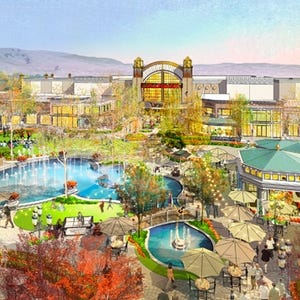The Forest for the Trees
Zooming out to see the real problems
We have a beautiful outdoor shopping center near our home. It has many restaurants, great stores, and is fun to just walk around. One of the fundamental problems is that it is virtually impossible to get to without driving, even if you live very close to it. And when you are there, the sections are not pedestrian friendly either. You have to either cross a major intersection or a vast parking lot to get to other areas.
Zooming out a little further, there are virtually no sidewalks connecting our city with the shopping area. Or connecting most of our small city together in general. Like most suburban municipalities, our town is completely car-centric. When we want to bike or walk to parks or shopping centers or other points of interest, we are forced to use a variety of small sidewalks and roads to get there.
The culture centers on driving. Even where there are sidewalks, most drivers aren’t expecting or thinking about pedestrians, making it unsafe.
While many large cities are more pedestrian friendly, that’s not the case for most cities in America. This has many causes, but as the article 5 Reasons Why Walking Your City (Most Likely) Sucks states:
This is common in most North American cities thanks to a combination of federal housing policy, single-use zoning, the influence of the automobile lobby, and an overreaction to industrialism...Walking your city sucks because everything is too far apart.
I had a great conversation recently on my other podcast, Product by Design where Florian Daniel and I discussed this topic. Florian founded a company and is now working for another that is tackling these issues—trying to get people to drive less and change their commuting habits. Check out that conversation below.
But why are we still here?
Optimizing Cars
In the United States and around the world, we have focused and continue to focus on optimizing cars and fuel efficiency. We are focused on tweaking things within the system rather than questioning the actual system (more on this in an upcoming post).
According to a press release on upcoming fuel efficiency standards from the NHTSA:
The new standards will increase fuel efficiency 8% annually for model years 2024-2025 and 10% annually for model year 2026. They will also increase the estimated fleetwide average by nearly 10 miles per gallon for model year 2026, relative to model year 2021.
We continue to optimize cars.
This is the same idea behind our growing obsession with coal-powered (sorry) electric vehicles. Electric vehicles tend to be better than gas powered vehicles (and will probably improve over time). But that’s tweaking within the system. We can optimize the cars we use, but that doesn’t change the system in which we’re using them.
Optimizing for Cars
Hitting close to home again, we have a new highway being built around the edge of our city. We vehemently opposed it, but our department of transportation knows how to do one thing: build new roads. And dammit, they are going to keep building new roads. When the only tool you have is a hammer…
Far from solving the problem of traffic and congestion, new roads and highways drive more traffic and congestion:
It’s the theory of induced demand: Building more roads and adding more lanes gives the appearance of speeding up traffic. But by encouraging sprawl, it spreads out stores, houses, and jobs, providing more reasons to drive more places and expanding many people’s commutes.
As Wired also pointed out in an article What's Up With That: Building Bigger Roads Actually Makes Traffic Worse, this works in reverse:
Perhaps the biggest success story has been in Seoul, South Korea, where the city tore down a highway that was considered a vital roadway corridor, carrying 168,000 cars per day. After replacing the cars with a river, parkland, and some smaller roads, traffic didn’t get worse and many other things, including pollution, got better.
Getting Stuck in Our System
It’s incredibly easy to get stuck in our system. We build roads because we’ve always built roads. We rely on cars because we’ve always relied on cars. We don’t consider alternatives because we’ve never really considered alternatives.
That is exactly what we saw when our state was considering the new highway. They did not consider any alternatives to a new highway. The only viable options were where to put the new highway. No one ever stopped to ask whether a highway was even the right idea for the future.
As Florian and I discussed on the podcast above, when you think about how much a new road and the road infrastructure costs, you could use that money to reward people for not driving or not taking their car and actually make money rather than paying for it.
Zooming Out
When we zoom out and consider the entire system, we’re able to see that the problem may not be optimizing the existing system, but rather changing it entirely.
Should we really be so car-centric as a society? Should we build our cities around the idea of driving everywhere? Or can we start to be far more friendly to other ways of traveling? And how can we accomplish that?
Rather than optimizing the system, how can we blow it up and make a system that works so much better?
As you look around, you’ll see other systems that we’re optimizing rather than questioning. I know I have. And will write about soon. Because we get so caught up in the water we’re swimming in that we don’t see the problems all around us. And that is at the heart of product thinking.





